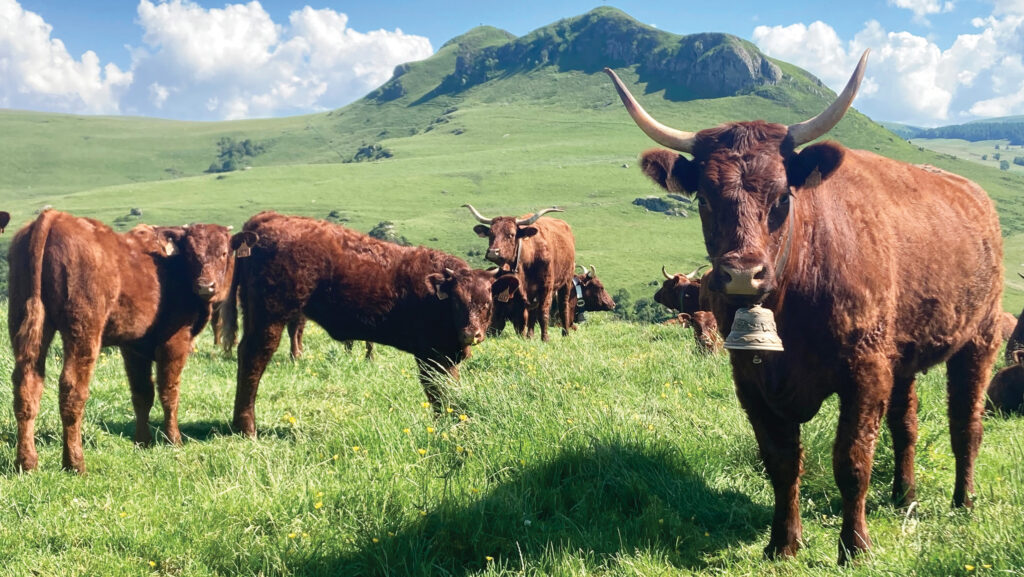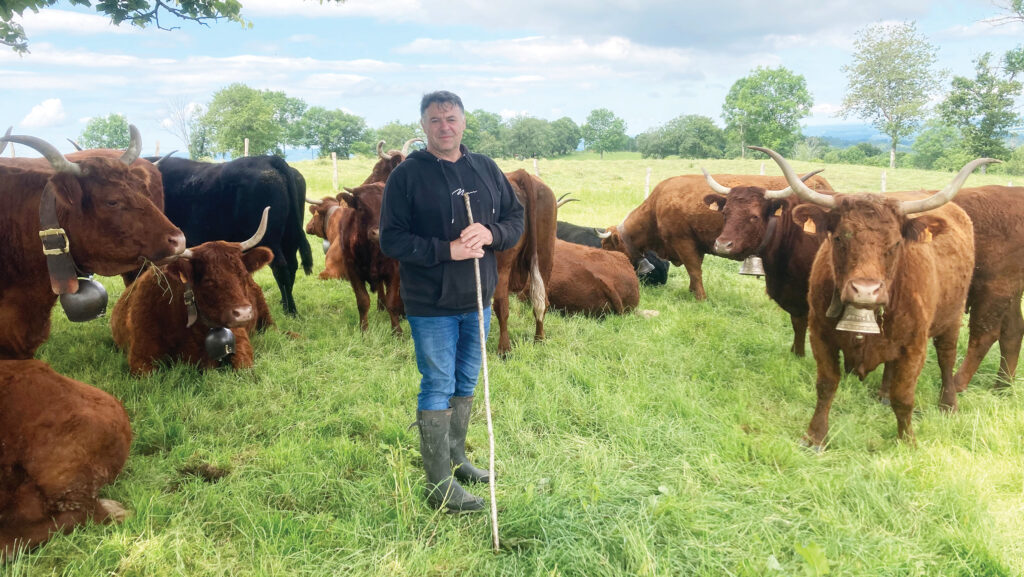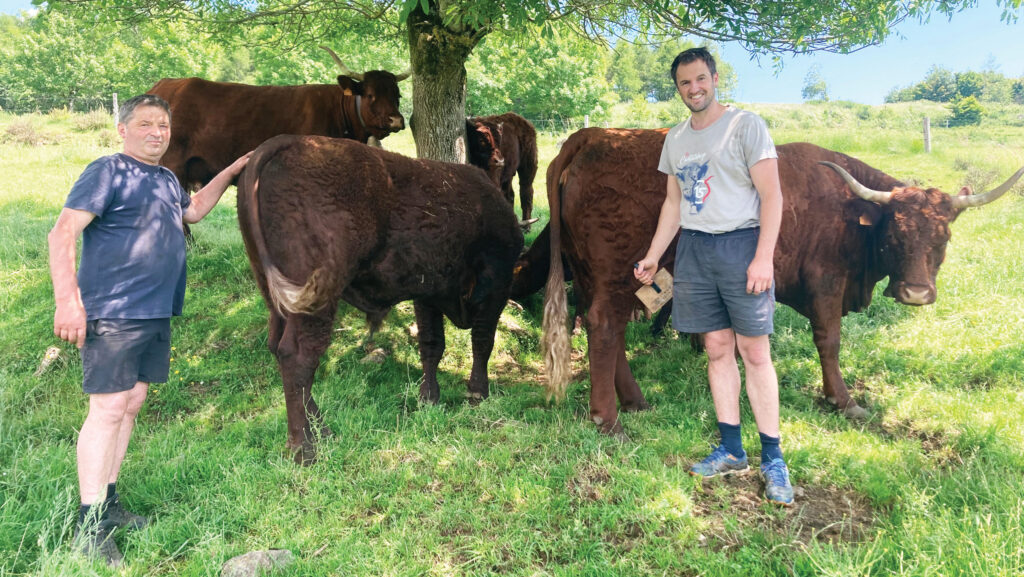What is behind French Salers breed’s calving ease?
 © MAG/Michael Priestley
© MAG/Michael Priestley Any breed growth in a sector that is contracting is worth attention.
This is true of many of Great Britain’s native breeds: ease of fleshing, calving ease and functionality have helped increase numbers of Angus, Shorthorn, Luing, and the composite Stabiliser in the past 20 years, while nationally, the suckler herd has contracted by 400,000 cows (down 22%).
The Salers breed from the mountainous Massif Central in France has also grown in popularity, increasing by 90% since 2003 to 40,700-head, which the Salers Cattle Society says makes it the UK’s seventh largest beef breed.
See also: How a Yorkshire suckler herd is achieving 96% calves weaned
Farmers Weekly examines why calving ease is so fundamental to this breed’s character, and how continual development of the breed is managed in France.
Salers breed facts
Maternal index
In France, one index is used, which prioritises calving ease and incorporates the following data:
- Calf weight and dimensions (length, width and weight all affect calving ease)
- Calf weight at 120 and 210 days (gauging milk and maternal ability)
- Calving interval and ability to have a calf every year
- One score for type classification and skeletal structure (19 measurements taken on hip width, height, length, dimensions and so on)
- One score for an optimal (not maximal) conformation.
Myostatin free
Some variants are linked to difficult calvings, so this gene is avoided.
Milk background
With dairy-type Salers (less than 10% of the breed) as well as beef, the breed has milk and calving records dating to 1925, and a 280-day gestation period.
Elite cows
There are 210,000 Salers cows, of which 70,000 are recorded. Of these, the top 5,000 high index cows (7%) are monitored as elite animals across many breeding units.
These cows must have at least one calf on the ground and be pregnant with their second.
Test station
Bulls from elite cows are selected by the breed association for entry into the bull test station at Salers. About 80 are entered at nine months old.
Pelvises are measured, type and structural soundness is assessed, and an average daily gain recorded on a hay diet (with small amount of concentrate) to grow 1.5-1.6kg/day.
After this process, 20 to 25 are typically rejected, leaving the rest to be sold at two public auctions.
Impartiality
Recording and indexing of cattle is overseen by government institutions (a condition of funding): calf weights are collected by Bovins Croissance (Cattle Growth Council), the index is run by the state-governed Institute d’elevage (Breeding Council) and INRAE (National Research Institute for Agriculture, Food and Environment) reviews breed society activity.
Ease of fleshing
Upland heritage and premium labels (Label Rouge for beef and Cantal cheese for dairy) stipulate a minimum grazing period of six months, and a diet of grass and conserved forage only, for finishing cows and milking cows.
Market signals
Cows are the prime beef animal in France because of their superior flavour and marbling. This means the hard calvings associated with E- and U-grade cattle can be avoided.
This summer, they made €1.20/kg (72p/kg) above conventional prime cattle, at €6.05/kg (£5.08/kg) deadweight for Label Rouge Salers females.
Outdoor calver records zero assistance

© MAG/Michael Priestley
A French farming family with an outdoor autumn-calving herd saw just six of their 110 purebred cows calve this year, and there were no assists.
Lionel Duffayet and family, who farm near Saint Cernin, 15 miles from Salers, say they can rely on the cows to produce 35-40kg calves without help.
“My main concern is tagging and recording the calf,” says Lionel.
Duffayet partnership farm facts:
- 110 pedigree cows bred pure
- 180ha, of which 100ha ploughable
- 20 bull calves sold for breeding
- 95% of heifers sold for breeding
- Rotation of maize, wheat and two to three years of grass
- Farm sits at 900m
Autumn calving
The herd calves in September and October because the farm is in a high rainfall area (1,300mm/year), making spring grazing challenging and usually delaying turnout until May.
An advantage of autumn calving is having older calves the following summer: July cattle trade is typically 12% higher, with pure Salers bulls making €3.40/kg (£2.84/kg) at nine to 10 months old for finishing in Italy.
Summer grazing is based on weekly rotations. Hay and salt are supplements fed at pasture only during particularly wet or dry spells between May and November housing.
Calving runs for about 12 weeks, with the Duffayets visiting cows in fields primarily to tag and record calves, not to watch calvings.
The Duffayets run a team of eight bulls and breed 25% of the herd (mostly first-time heifers) to artificial insemination. High index bulls are selected on docility, length and beef type, and pelvis structure.
Heifers calve at 24 months old, after spending their second summer grazing mountain pastures 20 minutes from the farm.
Housed period
Cows are housed from mid-November in a 10-year-old cow house with a slatted floor. Calves typically reach 150-200kg before Christmas, so they need a high energy diet to maintain growth rates.
Maize is grown as an energy source and mixed in equal parts with hay and haylage in winter and a mineral pack containing phosphorus and selenium, which is fed through a forage wagon.
Fertility sees 80% calve in 30 days

© MAG/Michael Priestley
A French upland farm is calving 80% of its cows in 30 days after focusing diligently on fertility and selecting from easy-fleshing animals.
Martine and Gerard Chassang and son Pierre Alain breed 90% of their females to artificial insemination with no synchronisation near Pierrefort, Cantal.
Cows calve indoors for eight weeks in January and February. They have a strong demand for their breeding stock and have sold or culled anything that fails to conceive on time.
Heat detection and insemination are aided by housing the cows between November and May.
With easy-calving genetics, having such a busy calving period is no issue, explains Gerard. “We sleep and they calve,” he says. “It’s no problem at all.”
Chassang farm partnership facts
- 180ha effective land farmed
- Three farms – at 700m, 1,000m and 1,300m above sea level
- 95% unimproved natural meadows
- 6ha maize
- 110 registered Salers all bred pure
- 1,200mm rainfall a year, with up to 2,000mm in the mountains
New building
A new shed with slatted flooring was erected with grant aid after Pierre Alain joined the family partnership in 2014. Slurry is applied to silage and maize ground.
Benefits of the new shed include a halving of straw use, from 10kg a cow to nearer 5kg. This amounts to 120t of straw for all females and followers. At a cost of £93/t, this saves £11,160.
In addition, air is fresher and teats are cleaner, which has lifted calf daily liveweight gain by 200g to 1.2-1.28kg.
Maize is added to a hay and haylage diet close to calving to emulate the energy levels of spring grass.
A shear grab on the rear of the tractor takes maize from the clamp, and forages are forked out by hand to save on buying a forage wagon.
